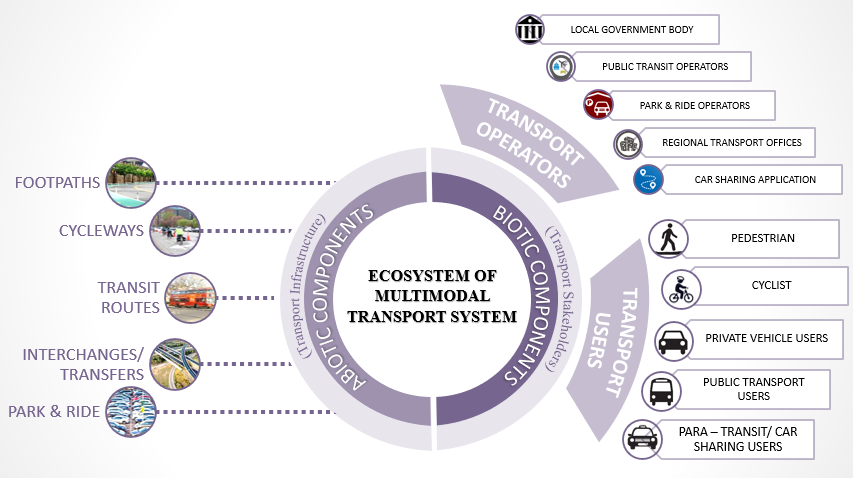-
CENTRES
Progammes & Centres
Location
The holistic approach is essential to overcoming the challenges associated with fragmented transport systems and building an integrated, user-centric, and sustainable multimodal transport system

Image Source: Getty
Historically, urban transport planning in India has been centred on balancing demand and supply, often overlooking the critical dimension of sustainability. Policies were predominantly oriented towards “moving vehicles rather than people,” resulting in a lack of focus on public transport (PT) systems, which could have mitigated transport-related externalities such as congestion, parking shortages, and accidents. Public transportation in Indian cities has mainly consisted of bus-based systems, including city buses and bus rapid transit systems (BRTS), as well as rail-based modes such as metro rail, suburban rail, tram networks, and shared mobility services under paratransit or Intermediate Public Transport (IPT) systems. Initiatives like public bike-sharing schemes and ride-hailing services such as Ola and Uber often complement these conventional modes of public transport.
However, following the implementation of the National Urban Transport Policy (NUTP) in 2006, the focus has shifted towards moving people rather than vehicles. In recent years, the Indian government has launched several initiatives, including the Smart Cities Mission, the Atal Mission for Rejuvenation and Urban Transformation (AMRUT), and the Green Urban Transport Scheme (GUTS), all aimed at promoting and enhancing PT, among other objectives.
In recent years, the Indian government has launched several initiatives, including the Smart Cities Mission, the Atal Mission for Rejuvenation and Urban Transformation (AMRUT), and the Green Urban Transport Scheme (GUTS), all aimed at promoting and enhancing PT, among other objectives.
Despite these efforts, while Tier I and II cities have 33 percent of their travel needs served by PT, its share in Tier III cities is only 4 percent. Bus modal shares vary significantly, from as low as 3 percent in Surat to 43 percent in Bangalore. According to urban transport policy guidelines, cities with populations of 1 million should have a public transit modal share of 40–45 percent, and those with populations of 5 million should have 75 percent of their mobility demand served by PT.
The prioritisation of highways and parking over investments in walking, cycling, and PT has mainly contributed to the inefficiency of transport systems in Indian cities. Moreover, the development of PT in India has been uncoordinated, with systems evolving independently of city size and population needs. The proposed PT systems after NUTP 2006 have faced conflicting objectives, leading to fragmented outcomes.
The lack of comprehensive and integrated transportation planning has made PT modes in metropolitan areas compete with each other, rather than function in a complementary manner. Consequently, while many cities possess multimodal transport systems, these remain largely “unintegrated” and “unsustainable.” Newer formal public transport systems fail to integrate with preexisting modes at operational, institutional, and informational levels. Furthermore, physical and fare integration between different modes of transport is absent in most Indian cities.
Physical and fare integration between different modes of transport is absent in most Indian cities.
An integrated and sustainable multimodal transport system (ISMTS) ensures the following:
Safety, with fewer road accidents and the physical safety of women, children, and elderly people
ISMTS also facilitates fair distribution of road space that is not skewed toward private motor vehicles. To guarantee such an ISMTS in Indian metropolitan cities, it is necessary to comprehend the interaction between the components of the multimodal transport system and derive a common conceptual framework that leads a city toward sustainable development goals.
The abiotic elements encompass transportation infrastructure, including footpaths, bike lanes, transit routes, interchanges, transfer stations, park-and-ride facilities, and drop-off points.
The ecosystem of a multimodal transport system comprises biotic and abiotic components. The abiotic elements encompass transportation infrastructure, including footpaths, bike lanes, transit routes, interchanges, transfer stations, park-and-ride facilities, and drop-off points. On the other hand, the biotic components consist of transport stakeholders, namely transit operators and users. The key agencies involved in urban transit operations include local governments, public and private transit service providers, regional transportation authorities and undertakings, park-and-ride operators, car-sharing organsiations, and IPT operators. On the user side, the city’s transport participants include pedestrians, cyclists, private vehicle drivers, captive transit riders, paratransit users, and car-sharing passengers. Figure 1 provides a schematic representation of a multimodal transport system ecosystem.
Figure 1: Multimodal transport system ecosystem

Source: Author’s creation
The sustainability of a multimodal transport system is determined by the effective coordination among these stakeholders, supported by integrated transportation infrastructure.
Creating an integrated multimodal transport system is a complex and multifaceted process involving various stakeholders with varied interests. Currently, PT systems in Indian cities operate in silos, with minimal or no integration between modes, creating significant challenges for commuters, including inadequate last-mile connectivity, the absence of pedestrian infrastructure, such as footpaths and cycling lanes, prolonged travel times, and discomfort or inconvenience when transferring between modes of transport.
As India rapidly urbanises, institutional integration of the public transport systems across Indian cities has become crucial. A key step towards achieving this is the establishment of a Unified Metropolitan Transport Authority (UMTA), which should be supported by a legal mandate. UMTA must be empowered to make decisions concerning all modes of transport within a city, ensuring a coherent and integrated approach to urban mobility.
As India rapidly urbanises, institutional integration of the public transport systems across Indian cities has become crucial.
Furthermore, urban planning documents such as the city’s Master Plan, Comprehensive Mobility Plan (CMP), and Development Plan (DP) for specific transport projects must be aligned to support the creation of an ISMTS. These plans should consider previous efforts and ensure that new transport infrastructure complements existing systems. When planning new modes of PT, attention must be paid to the design and execution of critical components such as multimodal hubs, co-located stations, and shared infrastructure to ensure the physical integration of different transport modes. Additionally, it is essential to coordinate the timetables and schedules across all modes of public transport. Implementing an integrated scheduling system would minimise waiting times and improve the overall efficiency of the transport network.
Moreover, cities must focus on achieving information integration by providing unified digital platforms, such as multimodal mobile applications, public information displays, standardised signage, and real-time updates. These measures will enable commuters to make informed decisions and facilitate seamless transfers between different modes of transport.
The holistic approach is essential to overcoming the challenges associated with fragmented transport systems and building a truly integrated, user-centric, and sustainable multimodal transport system in Indian cities.
Nandan H Dawda is a Fellow with the Urban Studies programme at the Observer Research Foundation
The views expressed above belong to the author(s). ORF research and analyses now available on Telegram! Click here to access our curated content — blogs, longforms and interviews.

Dr Nandan H Dawda is a Fellow with the Urban Studies programme at the Observer Research Foundation. He has a bachelor's degree in Civil Engineering and ...
Read More +